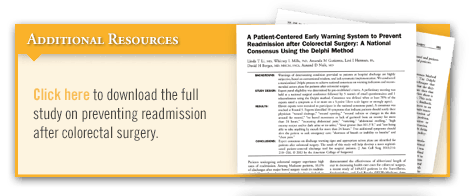About 16% of all colorectal surgical patients on Medicare are readmitted to the hospital within 30 days. These readmissions last more than 1 week, on average, and cost the healthcare system $300 million each year. Unfortunately, the warnings of deteriorating condition that are given to patients at discharge after such surgeries are highly subjective. Discharge instructions are often generic, based on conventional wisdom, and lack systematic implementation.
Ask the Experts
My colleagues and I had a study published in the Journal of the American College of Surgeons that aimed to develop a consensus on warning indicators and recommended action plans for patients after colorectal surgery. For our analysis, 11 nationally recognized experts in colorectal surgery engaged in five rounds of intense deliberation about warning signs that were most important to notice when patients were home after surgery and what should be done when specific complications occurred. We employed the Delphi method, a structured communication technique that uses iterative question-feedback-discussion rounds, to guide the expert panel’s deliberation and reach a consensus. Consensus was defined as having at least 70% of the experts “agreeing” or “strongly agreeing” on a particular point.
A consensus was reached on several symptoms that should prompt patients to contact their surgeons:
• Wound drainage, opening, or redness.
• No bowel movement or lack of gas or stools from an ostomy for more than 24 hours.
• Increasing abdominal pain.
• Vomiting.
• Abdominal swelling.
• High ostomy output and/or dark urine or no urine.
• Fever greater than 101.5 F°.
• Not being able to take anything by mouth for more than 24 hours.
Symptoms deemed serious enough to warrant a trip to the nearest emergency room included chest pain and shortness of breath.
The First Step
Our study represents the first step toward incorporating these warning signs into discharge instruction tools that are already well established. Even though discharge warning signs are routinely used, the wide spectrum of opinions from the expert panel underscore why our analysis was necessary. In some situations, experts had conflicting definitions of the same symptom—for example, deciding what temperature constitutes a fever.
With our analysis, it’s hoped that clinicians will recognize the importance of educating colorectal surgical patients and fostering communication. Patients should be empowered to recognize important warning signs and clearly understand what to do if they feel something is wrong after their operation. This may help decrease emergency care visits and readmission. It may also lead the way toward the development of a more sophisticated, patient-centered discharge tool.




 admin
admin